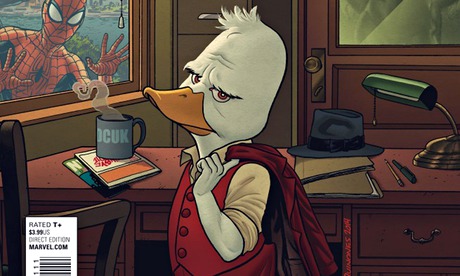
In March 2013, Marvel launched a new Guardians Of The Galaxy comic, bringing back cosmic characters who’d been in limbo for aeons. Two years and one hit blockbuster later, there are now five ongoing series featuring various Guardians, with a sixth – spotlighting Groot, the sentient tree – debuting in June. But perhaps the greatest achievement of Guardians Of The Galaxy has been to detoxify Howard The Duck, the bad-tempered bird who became a cult character in the 1970s.
Created by writer Steve Gerber and artist Val Mayerik as a satirical foil to clean-cut heroes of the time, this stumpy, shlubby fowl disrupted storylines in the Marvel universe, exasperating heroes and villains alike with his uncouth habits, including breaking the fourth wall. His cocktail-sipping turn opposite Benicio Del Toro in GOTG’s post-credits sequence was a surprising onscreen return, considering the George Lucas-produced Howard The Duck movie from 1986 still stands as one of the most notorious flops in film history. In the years since that disaster, Howard has kept a webbed toe in Marvel continuity by guest-starring in various stories, but now the comeback is complete with the launch of his own new solo ongoing series.
Written by Chip Zdarsky with art by Joe Quinones, it casts the cigar-chomping space duck as a classic PI – Howard the (private) dick, essentially – whose cases bring him into the orbit of Spider-Man, She-Hulk and other costumed heroes. The first issue is getting a big push across the Marvel line this month, with special What The Duck? variant covers, including a tribute to Munch’s The Scream that echoes Howard’s all-purpose catchphrase: “Waugh!”
David Lloyd knows a thing or two about shaking up the established order: he was the artist who collaborated with Alan Moore on V For Vendetta, the comic that sold a million Guy Fawkes facemasks. In recent years, Lloyd has expanded into publishing, overseeing Aces Weekly, an anthology published exclusively online. Other services will sell you digital versions of existing comics from a range of different publishers but Aces Weekly is its own standalone, bespoke product, with each volume collecting six strips from around the world. It feels hand-crafted, even old-fashioned, though the juxtaposition of veteran and rising talent and some wildly different art styles actually seems quite radical. Each volume contains more than 200 pages of quality comics and costs £6.99, with volume 15 launching earlier this month. Notable debuts include Argentinian writer-artist Monyo, with a newly coloured and translated version of his creepy deep space story Requiem, and UK-based Emma Chinnery, creator of the impressionistic, unsettling strip The Void.
Perhaps because he’s in the public domain, Frankenstein’s monster has become a familiar comics bolt-on. DC’s hulking incarnation recently had his collar felt by Batman as a grief-stricken Dark Knight researched reanimation techniques to try and resurrect a fallen ally. Over at Marvel, it wasn’t too long ago that the Punisher was chopped up into chunks, then brought back to life as the stitched-up, steampunk Franken-Castle (don’t worry, he transformed back eventually). Now Mike Mignola, creator of Hellboy and lifelong Boris Karloff fan, is putting his own spin on the classic creature in Frankenstein Underground, a new series published by Dark Horse.
This Frankenstein has already popped up in the sprawling gothic universe Mignola has carefully built around Hellboy over the last 21 years. Scrawny, yellow-eyed and tortured by existential questions, Mignola’s monster features some distinctive design flourishes, with three chunky bolts studded round his neck, and two more that look like nipples. Written by Mignola with art by Ben Stenbeck, the five-issue story begins with the creature seeking refuge in a Mexican temple in 1956 before being driven literally underground by the machinations of a sadistic, occult-dabbling French marquis. There’s no sign of Hellboy yet, though Mignola promises that what the monster discovers in the bowels of the Earth will trigger a crisis that affects the wider continuity.

